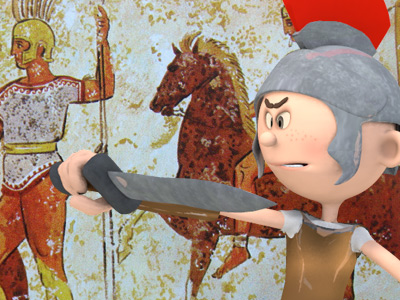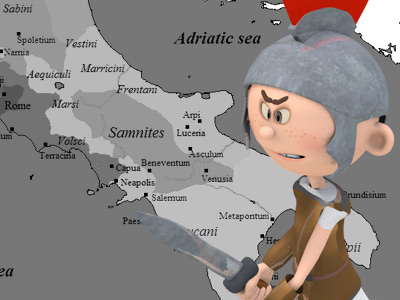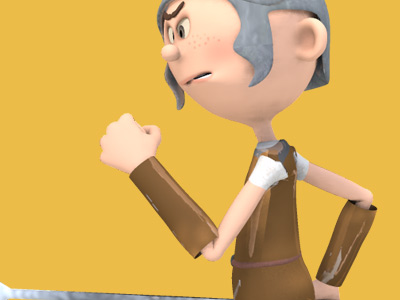Third Samnite War (298-290 BC)
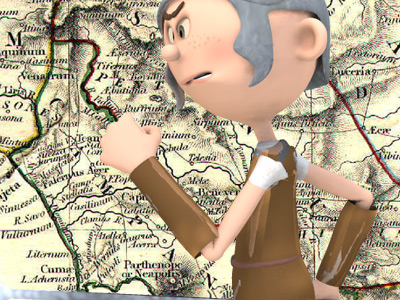
Aftermath
When the Samnite War ended, the Romans moved to crush the Sabines who lived on the mountains to the east of Rome. Manius Curius Dentatus pushed deep into the Sabine territory between the rivers Nar (today’s Nera, the main tributary of the River Tiber) and Anio (Aniene, another tributary of the Tiber) and the source of the River Avens (Velino). Spurius Carvilius confiscated large tracts of land in the plain around Reate (today’s Rieti) and Amiternum (11 km from L’ Aquila), which he distributed to Roman settlers. Florus did not give the reasons for this campaign. Salmon speculates that "it might have been because of the part they had played or failed to play in the events of 296/295 [BC]." They let the Samnites cross their territory to go to Etruria. Forsythe also speculated that it may have been a punishment for this. Livy mentioned that Dentatus subdued the rebellious Sabines. The Sabines were given citizenship without the right to vote (civitas sine suffragio), which meant that their territory was effectively annexed to the Roman Republic The Roman Republic was a form of government of Rome and the era of the classical Roman civilization when it was run through public representation of the Roman people. Beginning with the overthrow of the Roman Kingdom (traditionally dated to 509 BC) and ending in 27 BC with the establishment of the Roman Empire, Rome's control rapidly expanded during this period - from the city's immediate surroundings to hegemony over the entire Mediterranean world.. Reate and Amiternum were given full Roman citizenship (civitas optimo iure) in 268 BC.
The Roman Republic was a form of government of Rome and the era of the classical Roman civilization when it was run through public representation of the Roman people. Beginning with the overthrow of the Roman Kingdom (traditionally dated to 509 BC) and ending in 27 BC with the establishment of the Roman Empire, Rome's control rapidly expanded during this period - from the city's immediate surroundings to hegemony over the entire Mediterranean world.. Reate and Amiternum were given full Roman citizenship (civitas optimo iure) in 268 BC.
Cornell notes that Rome also conquered the Praetutii. They lived to the east of the Sabines, on the Adriatic coast and were at odds with the Picentes, who were Roman allies. With these two conquests the Roman territory extended into the Apennines area next to her and a strip of it stretched to the Adriatic Sea. This, combined with the mentioned alliances struck after the Second Samnite War with the Marsi, Marrucini, and Paeligni (304 BC) and the Vestini (302 BC), gave Rome control of this part of central Italy. The Samnites were forced to become allies of Rome which must have been on unequal terms. Rome offered a friendship treaty (foedus amicitiae) to those who allied with her voluntarily, but not to those who became allies as a result of defeat. The Romans also established a colony at Venusia, an important strategic point in south-eastern Samnium. The Lucanians retained their alliance with Rome. The result of the Samnite Wars was that Rome became the great power of Italy and controlled a large portion of it.
The alliances which developed after the Latin war, after the Second Samnite War, and at the beginning and the end of the third war laid the foundation for Rome to become the great power in the Mediterranean which defeated Pyrrhus and the Carthaginians and expanded into the Eastern Mediterranean. All the alliance treaties provided that the allies had to provide troops for Rome’s wars at their expense. The system worked because Rome supported the ruling elites of the allied peoples, who could turn to her in case of local troubles, and Rome shared the spoils of war, which could be considerable, with her allies. The allies also gained security, protection (Rome fought wars to defend their allies) and a share in the profits of conquest. The participation of allied troops had already become important in the Battle of Sentinum of the Second Samnite War. The Romans came to rely on the allies and their troops often greatly outnumbered those of the Romans. Polybius wrote that for the massive battle of Telamon against the Gauls in 225 BC, the Romans deployed about 41,000 Roman troops and 210,000 allied troops. It can also be deduced that the pool of Roman military manpower was about 40% of the total Roman and Italian pool, which Polybius estimated at 700,000. These were massive numbers which could not be matched by anyone else in the Mediterranean.
In 283 BC there was further Roman consolidation in Italy. There were clashes with the Gauls and the Etruscans. The sources lack detail and can be confused. According to Polybius in 283 BC unspecified Gauls besieged Arretium and defeateded a Roman force which had come to the aid of the city. The praetor Lucius Caecilius Metellus Denter died in the battle and was replaced by Manius Curius Dentatus. Dentatus sent envoys to negotiate the release of Roman prisoners, but they were killed. The Romans marched on Gaul (Polybius used this very vague term and must have meant Cisalpine Gaul) and they were met by the Senones who were defeated in a pitched battle. It can be assumed that this clash occurred in the ager Gallicus (the name the Romans gave to the area which had been conquered by the Senones), on the Adriatic coast (in modern Marche) as Polybius wrote that "the Romans invaded the territory of the Senones, killed most of them and drove the rest out of the country and founded the colony of Sena Gallia (Senigalia). Polybius also wrote that "[h]ereupon the Boii, seeing the Senones expelled from their territory, and fearing a like fate for themselves and their own land, implored the aid of the Etruscans and marched out in full force. The united armies gave battle to the Romans near Lake Vadimon, and in this battle most of the Etruscans were cut to pieces while only quite a few of the Boii escaped." He added that the next year the Boii and the Etruscans engaged the Romans in battle again and "were utterly defeated and it was only now that their courage at length gave way and that they sent an embassy to sue for terms and made a treaty with the Romans." Through these clashes the Romans gained further territory along the Adriatic coast, eliminated danger from the Senones and half a century without major conflicts with the Gauls followed. Polybius thought that Rome gained two advantages from these battles: she got used to defeating the Gauls, whom they had feared since the Gallic sack of Rome of 390 BC, and her troops became battle-hardened just before they had to confront Pyrrhus in the Pyrrhic War of 280–275 BC. In Etruria there were victorious clashes with Vulsci and Volsinii in 280 BC and Caere in 273 BC and the destruction of Volsinii in 264 BC.
HISTORY
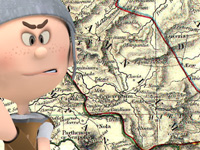
RESOURCES
This article uses material from the Wikipedia article "Samnite Wars", which is released under the Creative Commons Attribution-Share-Alike License 3.0.
© Stories Preschool. All Rights Reserved.
